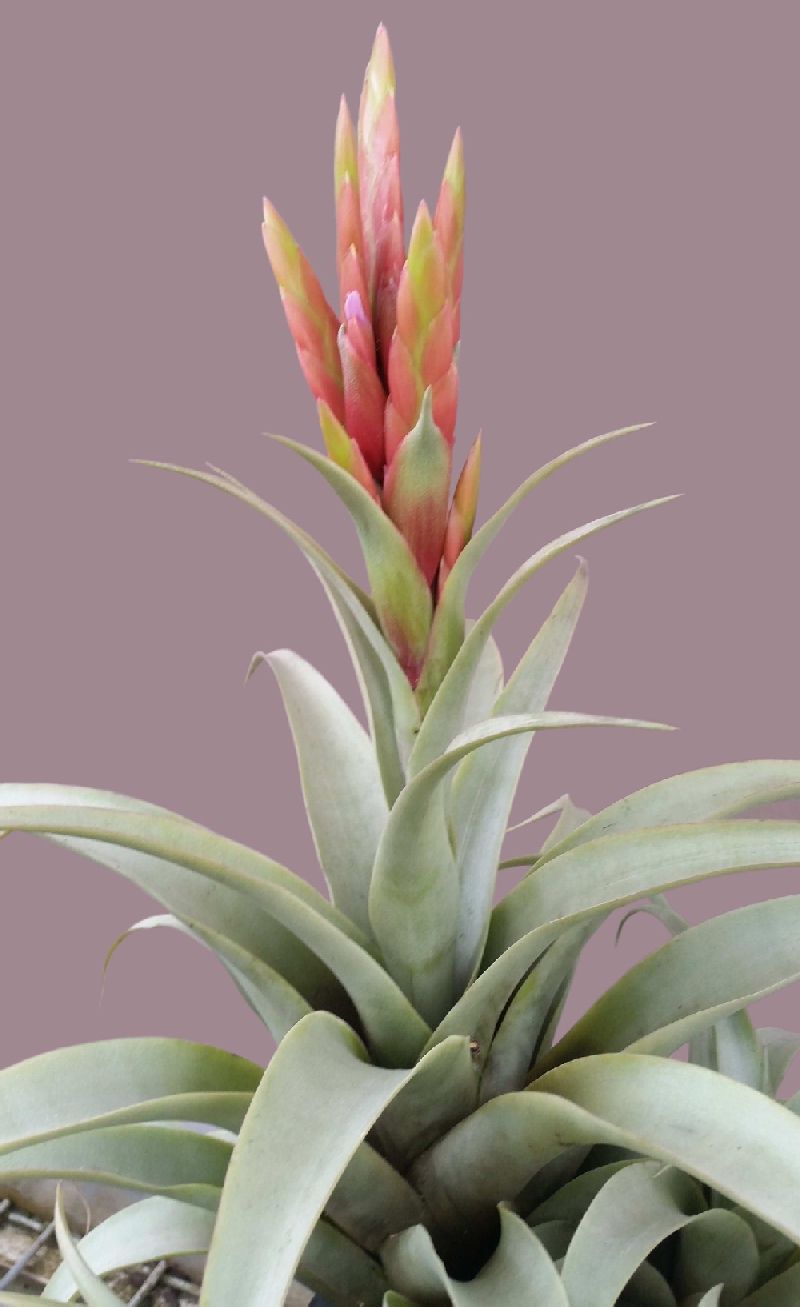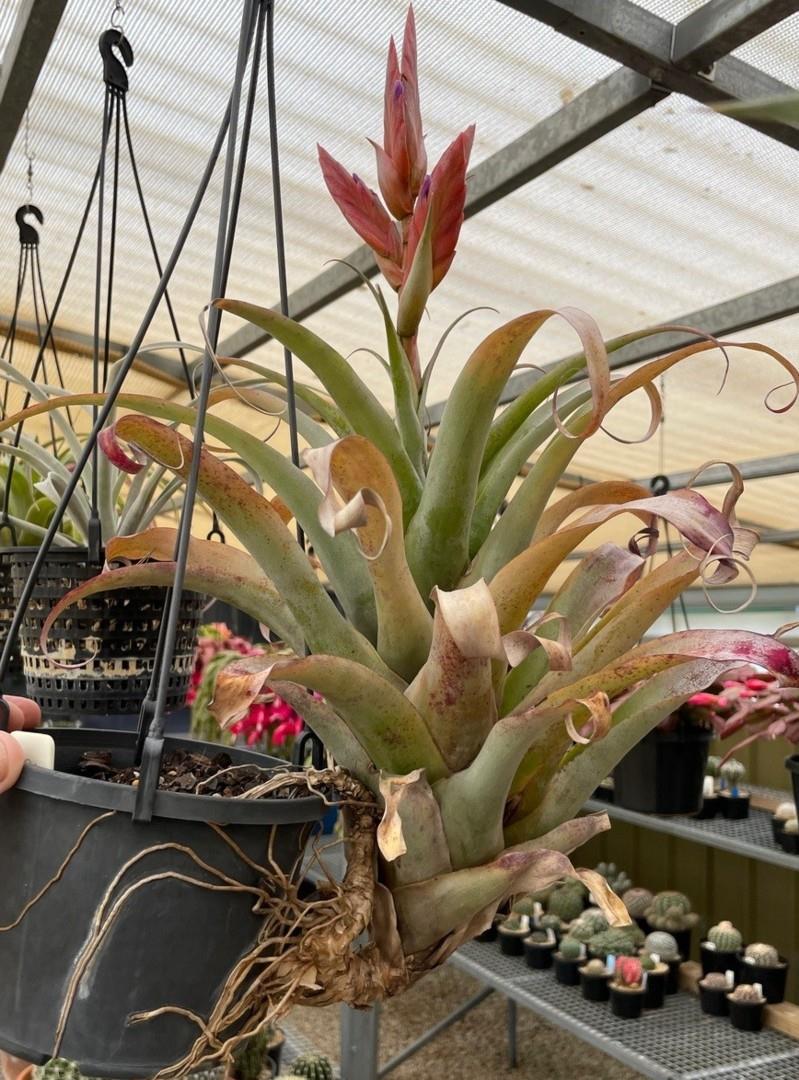





Plant stemmed, single or growing in clumps, flowering to 25cm high.
Leaves dense, polystichous, 10–20cm long, occasionally secund.
Leaf sheath 3.5–5cm wide, 6.5–8cm long, erect, elliptic, imperceptible blending with blade, the edges robustly bent and at the same time the inner ones becoming a cylinder, both sides dark brown, with brown appressed scales.
Leaf blade triangular, long acuminate, at the base 2.5–3.5cm wide, green or violet grey, dense grey appressed scales, the edges bent, the tips erect or bent outwards. Trichomes on the sheath and to the middle of the blade are a nut brown colour in the centre but from the middle to the tip the trichomes are not coloured.
Scape short, 4–6cm long, ca 7mm wide, erect, covered by the scape bracts.
Scape bracts longer than the internodes, the leaf sheath overlapping with the edges and entirely covering the whole stem, the lower ones similar to the leaves, elliptic, with shorter tips, 2–4cm long, the upper oval, at the base greenish with 5–20mm long 'spreitenrest', leaflike tips.
Inflorescence bipinnate, 5–7 sometimes 9cm long, with 3–4 spikes, or simple, its top exceeds the leaves by 6–10cm.
Primary bracts almost circular to broad elliptic, with entire shorter tip, to 2.5cm long, also the bottom few are half as long as the spike, shiny light green to yellow green, with thin red edges, scaled in the top half.
Spike densely erect or a few spreading, (4) 5.5–8cm long, (10), 14–22mm wide, lancelike tips, complanate, the smooth side towards the rhachis, almost sessile, (3) 6–11 flowered.
Flower densely distichous, scentless, nearly sessile, pedicel ca. 1mm long!,
Floral bracts 20–24mm long, as long as the sepals, elliptic, tipped, naked, leathery, green red, shiny, in fresh state not nerved, the tip weakly keeled, when dry strongly keeled, the tip abundantly scaled with small dense appressed trichomes, sepals hidden.
Sepal 18–24mm long, 6–7mm wide, longish lanceolate, with smaller 'aufgesetzter' tip, outside naked, inside richly nerved, with small brown centred trichomes with rhaphides, light green, thin, the edges thin membranous, the front not keeled and free, the posterior joined for 2–3mm, wing keeled.
Petal forming an erect tube, the tips densely bent together, light lilac, with succulent platte, white, and not succulent in the middle or bottom part, 30mm long, 4 – 5mm wide.
Stamens included in the flower, the top edge reaches the throat of the corolla, 27–28mm long, Filaments ca. as long or insignificantly longer than the style, filiform, smooth, white, the top part spirally twisted but not plicate, 22mm long. Anther fixed at base or near base, 5mm long, 0.7mm diam, yellow.
Style very slender, including lobes 17mm long, lobes erect, papillose, a little spreading, conduplicate, twisted, (see Type I Brown & Gilmartin 1984), pale pink.
Ovary light green, 5mm long, 2mm diam, conical.
Seed and placenta detail see original German description. Samenanlagen zylindrisch, mit eiformig verdickter Nuzellus region, am chalazalen Ende geschwarzt, ausseres integument am mikropylaren Pol etwas uber das innere verlangert, mit langem Stiel aufrecht an der Plazenta inseriert; Plazentation basal bis median.
Type Peru, Depto. Ancash, Prov. Huaraz, Cumbres de Huaraz, leg. K Knize s.n. (Holotype, WU) ; on the road to Huaraz, leg R & K Ehlers P7999, July 1979 (Paratype WU)
Distribution Central Peru, region around Huaraz, Dept of Ancash, saxicolous.
Differs from T. rubro-violacea in :
Smaller.
Caulescent habit.
Scape much shorter.
Only 1–4 spikes.
Posterior sepals are wing keeled.
Less connate.
Petals lilac pink.
Translated by Butcher
T. huarazensis is undoubtedly linked to T. rubro-violacea Rauh, but differs from this above all by having a very distinct stem, much smaller habit, the mainly lacking scape, less number of spiles, the different colour floral bracts, larger sepals, the posterior pair narrower connate between each other and moreover wing keeled and the mauve coloured petals. Maintaining T. rubro-vlolacea is in south Ecuador at a height of 1300m s.m. - also growing on rocks - whereas our plant comes from the northerly central Peru at a height of 2500-3000m s.m. With the Key of SMITH & DOWNS, 1977, one reaches T. nana Baker which grows in south Peru and north Bolivia but it is however not a near relative. In this position, is also seen the description of T. rubro-violacea in Trop. Subtrop. Pflanzenw. 27 (8). The description of all characteristics in the floral area do not coincide in the Holotype in the Herbarium of the botanical institute of the Universitat Heidelberg (HEID), which is why these are listed below:
Flower bracts 18-20mm long, as long or insigificantly longer than the sepals, acuminate, smooth; Sepals 15.5mm long, blunt, rounded at the top, outside glabrous, inside with small, brown centered, appressed trichomes, nerved when dry, wrinkled, membranous edges, asymmetric, anterior free and (almost) unkeeled, posterior pair 7-8mm connate; Petals 27(-30)mm long, rounded at the top; anthers 5-6mm long, narrow, yellow; Ovary conic, 5mm long, Style slim, with stigma 14.5mm long; Stigma lobes erect, papillose, type I - BROWN & GILMARTIN, 1984.
T. huarazensis, that largely resembles the floral features of T. rubro-violacea, can be understood to have some parallel relationship in this high Andean area. Similarly, there could also be a relationships with T. kuntzeana Mez in DC., 1896, in Bolivia which already Rauh, 1979 has indirectly reminded us, by bringing T. rubro-violacea into some sort of relationship with T. reuteri. If we consider the finds of T. huarazensis in central-Peru show an expansion of the range of the complex T. rubro-violacea/T. huarazensis there could be a connection to T. kuntzeana in Bolivia. More collections and examinations are necessary in this species complex.
Sept 2008
Dear Mr. Stolten, you are in a wasp-nest.
I have identified your plant as T. dudleyi because all details actually fitted. But I have not seen the Type, and on no account am I quite sure.
The plant from Jan Claus, that he has as T. dudleyi has a certain similarity. But the inflorescence is ellipsoid, 13-18cm long. The plant of Jan Claus has a long inflorescence that you cannot treat as more than ellipsoid. It could still have the same name (with some good will). I have another plant in my collection from Rauh 1983: R33049 with the name T. kunzeana. This flowered for the first time in Dec 2006. Photo enclosed. Since then I have not seen any T. kuntzeana, I don't know what that looks like. But Smith says it is 1m high. My plant is growing like your "T. dudleyi". The spikes should be 20 cm long, but they were not that.
What now concerns me are the plants of Knize-Dotterer, where all these are on no account T. huarazensis. I will email pictures separately.
I will ask Walter Till whether he can help us with his advice.
Cordially, Renate Ehlers